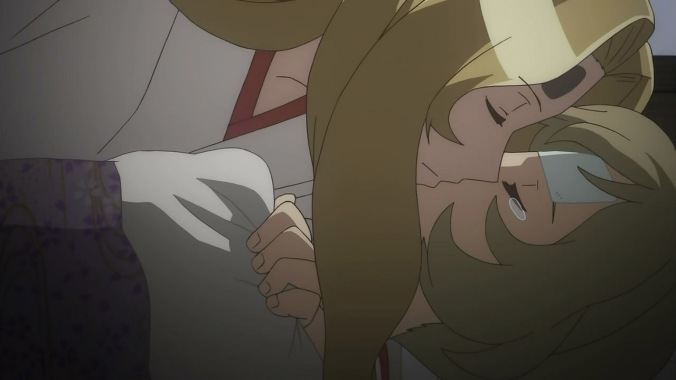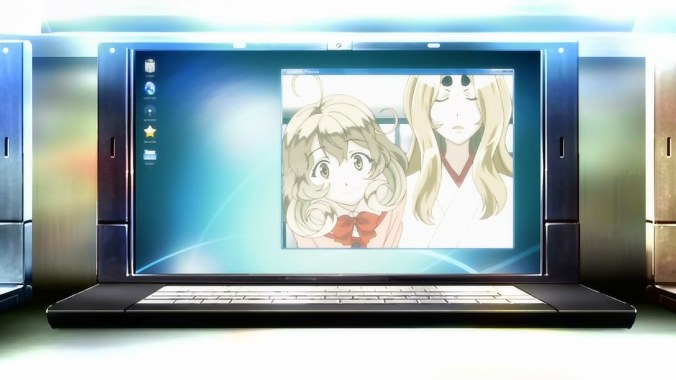Management: While my opinion of the show is positive overall, this essay, by no means, is meant to serve as a comprehensive review, but rather, as an articulation and analysis of some of what I feel is this series’ most integral and interesting themes. This piece has undergone a major re-write.
On the surface, Sasami-san@Ganbaranai is a strange concoction of battle spectacles, religion, and eccentric and risqué behavior brewed out of a Haruhi-inspired cauldron. The premise is a riff off of a Haruhi-inspired archetype, a girl who subconsciously alters the world using god powers she can’t consciously control. Inspiration is not imitation, however. While I’m not going to deny the influence The Melancholy of Haruhi Suzumiya has had on Sasami-san’s narrative, I’m confident in expressing this: Sasami-san’s is more ambitious than Haruhi’s, if not quite as smoothly well-written. It’s willing to talk about controversial issues in contemporary Japanese society that the Haruhi series is not really equipped to discussing. The show combines its fight scenes with its universe’s mythos, not unlike Monogatari, to craft a social commentary on Japanese religion and spirituality, as well as culture and lifestyles, in the New Age.
Unlike Monogatari though, Sasami-san’s universe is built primarily from extant Shinto kami mythology. However, all that needs to be known (if not fully appreciated) about this mythology to understand the show’s social commentary can be found within its narrative.
In the beginning, there was the great steward sun goddess Amaterasu. Tired of doing her job, she decided to seal her god powers within a female human vessel. That vessel went by the surname Tsukuyomi. These god powers were passed down, from generation to generation, through hereditary daughters dating their ancestry from the first vessel, the first Tsukuyomi Priestess. To maintain the quality of the vessels, these hereditary daughters were conceived via inbreeding to maintain the purity of the bloodline. These daughters also underwent self-denial training. Desires of duty toward humanity, the world, and the family would be emphasized. Desires of distraction that may have the potential to bend reality to their god powered wills would be suppressed. These god powers passed from Sasami’s ancestor, to Sasami’s mother, and finally, to Sasami Tsukuyomi herself.
Even a brief wandering of the mind, even an momentary impulsive longing can have the potential to bend reality to their own subconscious egoes. Many of the overt conflicts of the series is based around Sasami accidently triggering a reality-bending alteration of the world.
This alteration is countered in the universe by an equilibralating mechanism in the form of the three Yagami sisters, who have been tasked toward restoring the world to its original form. They are also there to protect and support Sasami as guardians, friends, and family. The true identities of the three Yagami sisters hail from the eldest Yagami, Tsurugi.
1. Tsurugi (center of the above screenshot) is an alias for the goddesss Amaterasu. Kagami and Tama are aspects of Amaterasu that have been split from the original body. As the, albeit now severely underpowered, Amaterasu, Tsurugi is representative of the old Japanese religion of Shinto.
2. Kagami (right of the screenshot’s center) is representative of scientific religion in the Japanese context, which, demonstrated by her abilities, combines both old religion and spirituality with emerging technology. Emblematic of the potential destructiveness (as well as constructiveness) of this emerging technology (the actual devastation having precedent in Imperial Japan), the narrative describes her backstory as one where she was raised for evil when she was kidnapped from Tsurugi, but tamed for good when she was retrieved back by the same person.
3. Tsurugi’s and Kagami’s character conceptualizations are derived from Shinto deities, Tsurugi being Amaterasu and Kagami being Kagutsuchi. Tama’s is not. Tama (left from the screenshot’s center) is a new god (alluded to by her grade schooler mentality) that whose defining ability is “eating.” This “eating” is interesting, especially in light of the conflict between Tama and Juju. Wait… who’s Juju?
The story goes from there that Sasami’s mother and the last arguably “true” Tsukuyomi Priestess, Juju Tsukuyomi, died. She died during Sasami’s childhood because of her frail constitution (which may or may not have anything to do with incest). Sasami’s austerity and training as a Tsukuyomi Priestess, incomplete at the time of her mother’s premature passing, wasn’t enough to make Sasami ready for her priestess duties like her mother Juju. Sasami as a kid saw what her mother did as awesomely literal superhero work. As she grew though, Sasami as a teenager began perceiving that work as less awesome and more of a burden. Without her mother’s presence to discipline and reassure her of the value of their hereditary clerical role, she took it less and less seriously over time. Exacerbated by a brief exposure to Akihabara and in charmingly modern vices (anime, manga, video games, the Internet, otaku paraphenalia) she finally abandons everything that she was previously raised for. Her austere practices, her traditional clothes, and even the family shrine… she leaves them all behind for the outside world and its floating pleasures.
Sasami promised Juju that she would take her place as a Tsukuyomi Priestess before she died. Either as some lingering spirit on earth or some wandering shade in a corner of yomi, Shinto’s version of the underworld, Juju at some point learns that she abandoned her promise and ran from her familial obligations to the world and humanity. Striking a deal with Susanoo, Shinto’s nearest equivalent to the devil, Juju reanimates back into her decaying corpse as a single-minded entity, determined to make her wayward daughter Sasami fufill her hereditary destiny. And if Sasami refuses, well… the rather… horrifing alternative of forcing her daughter to get pregnant with a girl. The new girl upon birth would then be trained closely by a zombiefied Juju in the ways of austerity, free of the external corruption of otaku modernity that Juju perceived as having compromised Sasami.
The Yagami sisters spring into action to protect Sasami. Tsurugi and Kagami are quickly defeated by Juju, the former thrown into yomi, and the latter impaled through the chest. With the both of them incapacitated, Tama faces off against Juju. Tama is able to both disarm her and “eat” holes into her body, all the while throwing a grade-schooler tantrum while yelling something to the effect of “I’m not smart” and “I don’t know” to Juju’s answer to “Why [do you] had to be so mean [to Sasami]?” On the verge of being “eaten” to oblivion, Sasami binds the weakened Juju with a spell she remembered learning during her priestess training. Tsurugi appears from yomi via a portal and throws the bound Juju back into it. The fighting ends.
How did Tama prevail where her Tsurugi and Kagami didn’t? What exactly about Tama allowed her to defeat Juju? Out of the Yagami sisters, Tsurugi is the eldest and wisest of the three, and Kagami is basically packing everything from missile launchers to Gatling guns. Tama is the youngest of the three, and she has the mentality of a kid. She fights during the standoff with Juju like a kid. “I guess her powers can do that” or “I suppose she was lucky.” Those answers are too contrived, too easy contrived answers. The actual answer can be found upon deeper digging.
The answer is all thematic metaphor. Tama isn’t a child in the narrative because of fetishism or just because. She’s a child because she is representative of a sort of New Age Movement in Japan, a more modern way of thinking religion, spirituality, culture, and lifestyles. In contrast to Juju’s mother, who represents the old conservative approach in Japan to religion and spirituality, Tama represents a newer, more liberating approach.
1. Juju is a strict believer of the traditional conceptions of Shinto, conceptions that demand certain kinds of austerity from its adherents through a dogma that connects the moral with the physical. These old conceptions demand absolutes in self-denial, discipline, and sacrifice in exchange for spiritual nourishment inextricably tied with the order of the world and humanity.
2. Tama is a new god, conceived by Amaterasu in the narrative, yet without any equivalent or precedent in actual Shinto mythology. Her place in the fight and in the show stresses the spirit, if not the exact law, that spiritual nourishment doesn’t have to be necessarily tied to the strictures of dogma found in traditional old conceptions of Shinto. These new conceptions provide the alternative notion that spiritual nourishment should be something that should make people happy, above everything else. As a result, people should approach spiritual fulfillment by choosing and sticking with whatever spiritual beliefs make them personally happy, regardless of whether or not they deviate from an established religion.
Within the heart of most religions, Shinto included, is the notion of a distinction between the sacred and the profane, the holy and the vulgar. Traditionally, the former is anathema to the latter. Juju and her traditional religious worldview rejects absolutely everything that Tama stands for. Believing in what Tama represents for, according to Juju, is arbitrary, too easy, too unearned, and thus “inauthentic.” Tama and her new spiritual worldview is willing to entertain and incorporate, in syncretic fashion, the doctrines and rituals of other religions, Juju’s included, as well as permit the creation of new doctrines and rituals altogether.
Believing in what Tama represents, according to Tama herself, may be arbitrary. It may allow for the creation of spiritual practices that are not austere to the level of established religious custom. It may cherry-pick practices from other religions that aren’t rigorous to the same degree as the established religious norm. This selectiveness doesn’t mean that this approach to spirituality is “inauthentic.” There is no essentialism, no indivisible core to what constitutes “true,” “real,” and “authentic” in this context save whether or not it provides personal happiness to the person concerned. It is the individual that decides their faith.
Tsurugi and Kagami were ultimately unable to best Juju principally because their combat abilities and their very existences are derived from the same traditional Japanese Shinto understanding. Most, if not all, of Tsurugi’s god powers are sealed away. Kagami relies on modern, but nonetheless profane, armaments. Juju is a Tsukuyomi Priestess reanimated from death in what appears to be her prime combat condition. Her prime was when she was killing supernatural and godly beings on a daily basis with divine and sacred armaments. Even if it was possible in a scenario for the profane to harm the sacred, the former would be typically characterized as weaker and inferior to the latter.
Tama’s existence doesn’t make the same distinctions between sacred and profane. Her “eating” ability is a reflection of an approach to spirituality by an individual that is open to entertaining anything that is sacred for their spirituality. Her acts of “eating” into Juju is a reflection that the individual is open to incorporating any religious belief and practice into their spirituality, whether that happens to be the whole of existing faiths or parts of existing religions. The resulting product of this new spiritual approach are new religions that operate according to their own logic.
Tama can weaken Juju to this extent because Tama’s abilities do not play by Juju’s rules.
They play to Tama’s own. As long as Juju is supernatural, Tama can “eat ” and defeat her.
This new approach to religion and spirituality can be applied to culture and lifestyles as well. Religion and spirituality affects how people see culture and practice lifestyles in the obvious ways. However, it also affects common sense perceptions of approaching tradition. In the traditional Japanese context, strict adherence to tradition, as encompassed in ideas such as filial piety and family obligation, is something that is seen as a grave and inherent sin to violate because of how it is objectively intertwined to the welfare of the moral and physical order of the world and humanity.
Juju insists that Sasami fulfill her Tsukuyomi duty as a Tsukuyomi Priestess for the world and humanity. However, In the combined modern, globalized, and New Age context, the physical order is not largely seen to be intertwined objectively to the moral order, and thus people are seen as free to follow or deviate from tradition how they like. Tama insists that Sasami should be allowed to refuse her duty as a Tsukuyomi Priestess. The world and humanity is not automatically Sasami’s responsibility. She should choose how she approaches that duty based on what makes her happy.
In the middle of these diametrically opposite ideological camps is Sasami herself, who is a new generation of Japanese torn between two sides, two worlds. On the one hand, she embraces many of the values of the New Age. She finds personal happiness in her new lifestyle with the Yagami sisters, different in many radical respects to her old lifestyle in the family shrine. On the other, she was born and raised by the old generation and taught its traditions. Sasami was raised by a Juju who both believed in these traditions as Juju, Tsukuyomi Priestess, but nonetheless adored, cared for, and, despite the austerity training, occasionally doted on Sasami as Juju, Sasami’s mother. Sasami loved her in turn. That affection did not reverse as she aged.
The Juju who reanimated and tried to force Sasami back into the family role (and later tried to forcibly impregnate her when her those efforts failed) purged herself of her mother side so that she would be unable to temper the extremes of her ideology with the compassion of her human motherliness. At the same time, her ideology serves the practical function of storing Amaterasu’s god powers within a relatively safe place. Within that place, it would not be abused by others for nefarious purposes. Sasami was taught of this practical function while being raised by someone who was important to her. She re-discovered how important serving that function happens to be.
Sasami comes up with a compromise between the two camps. She will not return to becoming a Tsukuyomi Priestess in the way that Juju and tradition had originally intended. She will transfer Amaterasu’s god powers to a conveniently revived (and not zombiefied) Juju that is both Tsukuyomi Priestess and her mother. Knowing that her mother will not always be there to fulfill the Tsukuyomi Priestess function, she has promised to take back those god powers when she is older. It allows her the opportunity both to live her own life and mature from her own mistakes until the point comes that she’s ready to deal with storing those god powers as a responsibility she freely chooses to take up.
What Tama and even Sasami, compromising as Sasami in particular may be, represent is a deviancy from conservative and, to a certain extent, mainstream Japanese values. Conservative and mainstream Japanese have to tendency of disavowing themselves from these alternate religious, spiritual, cultural, and lifestyle approaches. They have a tendency to alienate themselves from those that depart from tradition. This conflict within societies, Japanese society especially, between tradition and New Age in culture and religion is why the issue is so controversial. The level of sophistication and nuance Sasami-san goes into, using Monogatari-like metaphor, to illustrate and comment on this issue is nothing short of enlightening.














